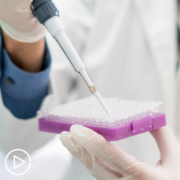Ivosidenib and Azacitidine for IDH1-Mutated AML
There has been another significant advance in the treatment of Acute Myeloid Leukemia (AML) at least for the small subset of patients (6-10%) who have a mutation in one of their genes called IDH1 (isocitrate dehydrogenase 1).
Until 5-7 years ago, the typical initial treatment (called induction) for patients with AML consisted of relatively high doses of cytarabine (Ara-C) and another chemotherapy called an anthracycline (usually either daunorubicin or idarubicin). Cytarabine is given as a continuous infusion for seven days and a daunorubicin or idarubicin is given on the first 3 days (this is commonly referred to as “7 + 3“regimen). There are other regimens that are sometimes used although most contain cytarabine. This regimen is effective, but quite toxic and usually reserved for healthier fitter patients (generally under 65 without comorbidities like diabetes, or certain heart conditions).
In 2018, the Food and Drug Administration (FDA) approved venetoclax and azacitidine for use in older patients or those with comorbidities. Earlier this year, FDA approved Iivosidenib (used in combination with azacytidine) for newly diagnosed AML patients an IDH1 mutation. The approval was for “adults 75 years or older, or who have comorbidities that preclude use of intensive induction chemotherapy”. This was based on a clinical trial reported in the New England Journal of Medicine (NEJM): Ivosidenib and Azacitidine in IDH1-Mutated Acute Myeloid Leukemia,. Ivosidenib is not a brand new drug, it was approved in 2018 for relapsed or refractory AML.
The current approval was based on a global, double-blind, randomized, placebo-controlled trial comparing AML patients with an IDH1 mutation treated with ivosidenib and azacytidine with patients treated with azacytidine alone. The primary end point of the trial was event-free survival (EFS), defined as the time until treatment failure (i.e., the patient did not have complete remission by week 24), relapse or death. The first group of patients, who received ivosidenib had an EFS at 12 months of about 37% versus 12% in the placebo group. In addition, the median overall survival (that is half of the patients lived at least this long) was 24.0 months with ivosidenib and azacitidine versus 7.9 months with azacitidine alone. This is a big difference, although there is still a lot of room for improvement. In addition, there were fewer infections in the ivosidenib, group although there were more incidences of low white blood counts (neutropenia) and bleeding in that group.
While this is good news, showing ivosidenib (Tibsovo) and azacitidine (Vidaza) is better than azacitidine alone, most patients with AML with an IDH1 mutation who are not good candidates for intensive induction chemotherapy during the time period of the trial would likely have been treated with azacitidine and venetoclax (Venclexta). The combination has been shown to be much more effective than azacitidine alone. My guess is that azacitidine alone was chosen as the comparison, since the ivosidenib trial started enrolling patients in March 2018 (presumably the protocol for the trial was completed several months before that) and venetoclax was not approved until November, 2018. The question remains, which is better ivosidenib and azacitidine or azacitidine and venetoclax. I believe we will probably never know. Given that AML is already a rare disease and no more that 10% of AML patients have an IDH1 mutation, it is not likely such a trial would be done. Instead, it seems more likely that trials will look at the 3-drug combination of ivosidenib, venetoclax and azacitidine. Perhaps a trial with 3 arms may be done, comparing azacitidine with ivosidenib, or venetoclax or both. I hope the 3-drug combination will be more effective than either ivosidenib or venetoclax combined with azacitidine. If the side effects are not much worse, then standard therapy for AML patients with an IDH1 mutation who are not good candidates for intensive chemotherapy would become the 3-drug combination. This would happen faster than first comparing ivosidenib to venetoclax and then comparing the better of those two to the 3-drug combination. For younger healthier patients, ivosidenib is being combined with intensive chemotherapy in clinical trials.
Further reading:
Ivosidenib and Azacitidine in IDH1-Mutated Acute Myeloid Leukemia, the original article from the New England Journal of Medicine (N Engl J Med 2022; 386:1519-1531).
Ivosidenib and Azacitidine for IDH1-Mutated AML, mostly a repeat of the abstract of the above NEJM article, but also includes some commentary.
Ivosidenib with Chemotherapy New Option for Some People with AML an article on Ivosidenib and Azacytidine from Cancer Currents: An NCI Cancer Research Blog.
This AML Treatment Option is an Alternative to Induction Therapy an article on Ivosidenib and Azacytidine from PatientPower.
FDA approves ivosidenib in combination with azacitidine for newly diagnosed acute myeloid leukemia an article about the drug approval, from Practice Update (registration may be required).
Ivosidenib or enasidenib combined with intensive chemotherapy in patients with newly diagnosed AML: a phase 1 study, an article in Blood (Volume 137, Issue 13, April 1 2021) about a preliminary study of Ivosidenib and Enasidenib (for patients who have a mutation in IDH2) along with intensive chemotherapy (“7+3” induction, Ara-C consolidation).
FDA grants regular approval to venetoclax in combination for untreated acute myeloid leukemia, an article from the FDA on the approval of Venetoclax for treating AML (October, 2020).
FDA approves first targeted treatment for patients with relapsed or refractory acute myeloid leukemia who have a certain genetic mutation, an article from the FDA on the initial approval of Ivosidenib for treating AML (July, 2018).FDA approves first targeted treatment for patients with relapsed or refractory acute myeloid leukemia who have a certain genetic mutation, an article from the FDA on the initial approval of Ivosidenib for treating AML (July, 2018).

AML Network Manager
Art Flatau lives in Austin, Texas with his wife Gretchen. They have 2 grown children. He was diagnosed with Acute Myeloid Leukemia (AML) in 1992 at the age of 31, while still in graduate school at the University of Texas. Gretchen and Art’s kids were 2 and 4 at the time. He received chemotherapy (both induction chemotherapy and then consolidation). After graduating with a Ph.D. in computer science in December 1992. He relapsed in early 1993 and then had a bone marrow transplant (BMT), his brother was a perfect match.






